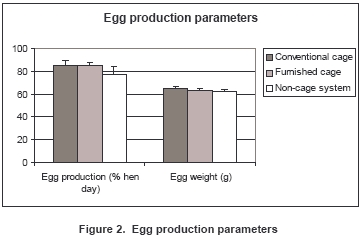WP 6: Productivity and Egg quality
The objective of WP6 was to describe the productivity and egg quality traits of laying hens in different production systems in relation to welfare. Observations from unenriched cages, enriched cages, barn systems, and aviaries using laying hens of a number of breeds and at a range of stocking densities, over full laying cycles and up to commercial flock scale will be used.
WP6 considers how the data contribute to our knowledge of welfare, and the suitability of various productivity variates as welfare indicators will be discussed. Information and data from partners in UK, Sweden, France, Germany, Netherlands and Spain will contribute to WP6. Available information from accession countries, and where relevant from elsewhere, will be comprehensively incorporated.
WP6 will put special emphasis on:
- Measuring, and relating to welfare, egg production, egg weight, egg output, bird body weight, egg quality, second quality eggs, feed intake and mortality in unenriched cage systems, enriched cages, barn systems and free range systems.
- The connection between production data and the welfare indicators identified in WP1 .
The output of WP6 wasa report presenting an overview of productivity and egg quality traits relevant for bird welfare, their connection with welfare indicators and the differences in these traits related to housing system.  The production parameters overall, show that production is less efficient in non-cage systems (e.g. higher feed conversion ratios).
The production parameters overall, show that production is less efficient in non-cage systems (e.g. higher feed conversion ratios).
The results indicate however, that the performance of birds in the different types of furnished cages is not worse than that of those in conventional cages. The egg quality parameters such as cracked and dirty eggs show that egg quality in furnished cages is dependent on cage design, but does not need to be a problem with the right cage design. The design of furnished cages has further improved recently and production parameters from these new models should be evaluated to get a more up-to-date picture of production in small, medium and large group furnished cages. This would require a short extension to the data population and use of the LayWel database, which would be well worthwhile.
The LayWel data on production parameters clearly illustrates the high use of the nest box for laying eggs by laying hens and therefore the high risk to welfare of hens in conventional cages when nesting is not possible. As discussed in Workpackage 4, the high use of nest boxes indicates that laying hens place a high value on a discrete nest space. Use of the nest box may therefore be used as an indicator of welfare. If the use of the nest box is low (e.g. due to poor design) or decreases over time, the needs of the hens are not met.
The conclusions of WP6 are that the main production parameters (feed and water parameters and egg production parameters) are not suitable as important indicators of welfare, but they should be monitored continuously and used as an indicator that welfare may be or become impaired. Nest box use can be used as an indicator of welfare as laying hens place a very high value on laying eggs in a secluded area.
| Description | download |
| 6.2 Report on production and egg quailty |